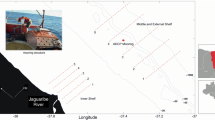Abstract
The bottom currents in the Challenger Deep, the deepest in the world, were measured with super-deep current meters moored at 11°22′ N and 142°35′ E, where the depth is 10915 m. Three current meters were set at 9687 m, 10489 m and 10890 m at the station in the center of the Challenger Deep for 442 days from 1 August 1995 to 16 October 1996. Although rotor revolutions in 60 minutes of recording interval were zero for 37.5% of the time, the maximum current at the deepest layer of 10890 m was 8.1 cm s−1, being composed of tidal currents, inertia motion and long period variations. Two current meters were set at 6608 m and 7009 m at a station 24.9 km north of the center for 443 days from 31 July 1995 to 16 October 1996, and two current meters at 6214 m and 6615 m at a station 40.9 km south of the center for 441 days from 2 August 1995 to 16 October 1996. The mean flow at 7009 m depth at the northern station was 0.7 cm s−1 to 240°T, and that at 6615 m depth at the southern station was 0.5 cm s−1 to 267°T. A westward mean flow prevailed at the stations, and no cyclonic circulation with mean flows of the opposite directions was observed in the Mariana Trench at a longitude of 142°35′ E. Power spectra of daily mean currents showed three spectral peaks at periods of 100 days, 28–32 days and 14–15 days. The peak at 100 day period was common to the power spectra.
Similar content being viewed by others
References
Anonymous (1992): Atlas of the Sea, ed. by Japan Hydrographic Association, Maruzen Publishing Co., Tokyo, 119 pp. (in Japanese).
Fujio, S., D. Yanagimoto and K. Taira (2000): Deep current structure above the Izu-Ogasawara Trench. J. Geophys. Res., 105, 6377–6386.
Hallock, Z. R. and W. J. Teague (1996): Evidence for a North Pacific Deep Western Boundary Current. J. Geophys. Res., 101, 6617–6624.
Johnson, G. C. (1998): Deep water properties, velocities, and dynamics over ocean trenches. J. Mar. Res., 56, 329–347.
Mitsuzawa, K. and G. Holloway (1998): Characteristics of deep currents along trenches in the northwest Pacific. J. Geophys. Res., 103, 13,085–13,092.
Owens, W. B. and B. A. Warren (2001): Deep circulation in the northwest corner of the Pacific Ocean. Deep-Sea Res. I, 48, 959–993.
Taira, K. (1987): Direct measurements of bottom current in Izu-Ogasawara Trench. Chigaku-Zasshi, 96, 429–433 (in Japanese).
Taira, K. (1988): Development of super deep housings for oceanographic instruments. Japanese Scientific Monthly, 41, 412 (in Japanese).
Warren, W. A. and W. B. Owens (1985): Some preliminary results concerning Deep Northern-Boundary Currents in the North Pacific. Prog. Oceanogr., 14, 537–551.
Author information
Authors and Affiliations
Corresponding author
Rights and permissions
About this article
Cite this article
Taira, K., Kitagawa, S., Yamashiro, T. et al. Deep and Bottom Currents in the Challenger Deep, Mariana Trench, Measured with Super-Deep Current Meters. J Oceanogr 60, 919–926 (2004). https://doi.org/10.1007/s10872-005-0001-y
Received:
Revised:
Accepted:
Issue Date:
DOI: https://doi.org/10.1007/s10872-005-0001-y



